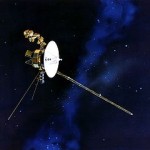
A bit of Uranus and some of its moons. Titania and Oberon are the last two on the right.
William Herschel discovered Titania and Oberon, the two largest moons of Uranus, in 1787. Herschel, a German-born astronomer who had moved to England, discovered Uranus in 1781. Today we know Uranus has 27 moons and a ring! Herschel named the two moons after characters in Shakespeare’s “Midsummer Night’s Dream.” Children can learn more about the moons of Uranus at: Moons of Uranus.

